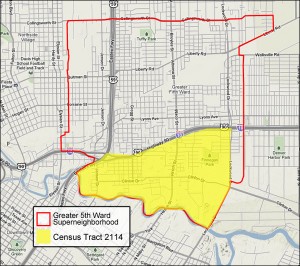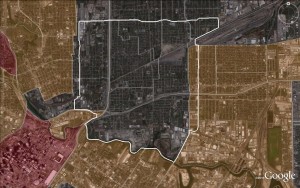Lisa Gray writes about a popular art project making a reappearance in a new place.
Six years ago, the white guys – Dan Havel and Dean Ruck – smashed up a couple of other bungalows, and in the process, created Inversion, one of the most astounding of pieces of art that Houston had ever seen. A giant horizontal vortex, made from the bungalows’ own wood siding, seemed to rip through the houses – a sight that literally stopped traffic on Montrose Boulevard.
It was public art that the public loved. People who never set foot in galleries asked their neighbors whether they’d seen it. Parents snapped photos of their kids crawling into the funnel’s mouth; dog owners snapped photos of their mutts peeking out the little hole at its tail. Pranksters stuck Realtors’ signs out front. Inversion appeared on Christmas cards, newspapers, magazines and the TV news. And naturally, it was a Web sensation.
But it was easy, too, to read meaning into the spectacle. Montrose, like other neighborhoods, was gentrifying fast. Its bungalows and other old houses were disappearing; townhouses and highrises seemed to appear overnight, out of nowhere. The time-space continuum seemed in flux. The past was being sucked into the future. A vortex was ripping through.
[…]
Fifth Ward Jam, as Havel and Ruck call the piece they recently finished, isn’t at all a copy of Inversion. Jam is made from one bungalow instead of two, and it has multiple vortexes, not just one. In front of all the wooden chaos, there’s an area that could serve as a stage. But anyone who remembers Inversion will immediately recognize Jam as its kin.
The main difference, really, is the site: The Fifth Ward is wildly different from arty, gentrifying Montrose. In the past decades, change has crept in, here and there – a new-ish apartment complex sits directly across Lyons Avenue from Jam – but the neighborhood remains much the same: mostly African American, mostly poor. Weedy lots and vacant houses are problems here; gentrification and whirlwind change are not.
One of the things I like about doing candidate interviews is that they give me an opportunity to visit different parts of the city. To interview the candidates in District B, I made several visits into the Fifth Ward, which is a neighborhood I can’t honestly say I’d been to before. One of these interviews took me past Fifth Ward Jam, which was cool to see. But what really struck me as I drove around was how close this all was to downtown. Gentrification and whirlwind change may not be a part of the Fifth Ward today, but I think it’s inevitable, and frankly is probably just around the corner. If you look at the neighborhoods surrounding downtown, it’s what’s left for redevelopment. The Heights, the Washington corridor, Neartown, the Museum District, Montrose, and Midtown are all pretty much built out – for sure there’s little if any cheap property available in any of them. EaDo and the Near Northside are getting there. But east of 59 and north of I-10, it’s as Gray describes it. If you’re a real estate developer, you’ve got to see the potential there.
And, while I get what Gray is saying about an absence of change in the Fifth Ward, the Census number suggest otherwise. Take a look at the demographics of the neighborhood and how they compare to a decade ago:
------------------------------------------------------------------ Hispanic Afr-Am Asian Anglo Tot. Pop ------------------------------------------------------------------ 2000 7,943 (36.3%) 13,464 (61.5%) 62 (0.3%) 327 (1.5%) 21,879 2010 8,735 (45.3%) 9,739 (50.5%) 85 (0.4%) 556 (2.9%) 19,288
That’s quite a bit of change. In particular, I find the drop in the number of African-American residents stunning. The fact that the population declined overall, by more than ten percent, is further evidence to me that the area is ripe for redevelopment. Who’s going to be there to resist it?
Just so we’re all clear, the data above refer to the highlighted area in this map:
The yellow area at the southern end is Census Tract 2114, and it’s likely a leading indicator for the Fifth Ward as a whole:
Tract 2114 -------------------------------------------------------------------- Hispanic Afr-Am Asian Anglo Tot. Pop. -------------------------------------------------------------------- 1980 421 ( 8.2%) 4,664 (90.8%) 10 (0.2%) 36 (0.7%) 5,137 1990 554 (14.4%) 3,228 (84.2%) 28 (0.7%) 24 (0.6%) 3,837 2000 921 (25.4%) 2,609 (72.1%) 17 (0.5%) 59 (1.6%) 3,620 2010 1,310 (35.5%) 1,986 (53.8%) 70 (1.9%) 288 (7.8%) 3,690
Note the jump in Anglo population, which while still quite small in absolute terms seems likely to grow, as this portion of the Fifth Ward abuts and arguably overlaps EaDo. As with the greater Fifth Ward, the African-American population has dropped off considerably, while the Hispanic population has increased, though not nearly enough to make up for the African-American decline. It will be very interesting to see how the population mix in this area changes over the next decade. Speaking of which, here’s a comparison of the Fifth Ward’s demography from 1980 and 2010:
Areas with an African-American majority are colored black in the maps above; those with a Hispanic majority are brown, with an Anglo majority are red, and with no majority are either yellow or green, depending on your monitor settings. Like I said, this area has already seen a lot of change, more than you might have thought if your frame of reference is like mine. I believe this change will be more visible to those of us who do not live there in the coming years.
All Census data and images come courtesy of Greg Wythe, whose wizardry in these matters regularly amazes me. My sincere thanks to him for helping me illustrate the point I wanted to make. Finally, on a side note, Robert Boyd highlights another eye-catching piece of art in the Fifth Ward, and JR Gonzales has some excellent photos of the area from the 1950s. Check ’em out.




Pingback: Eye on Williamson » Texas Blog Round Up (October 10, 2011
Pingback: Texas blog roundup for the week of October 10 – Off the Kuff
Pingback: You Can Start An Occupy Movement In Your City—Texas Progressive Alliance Round-Up « Texas Liberal
Pingback: Roundin’ up the TPA | McBlogger
Pingback: Where the poverty is – Off the Kuff
Pingback: Our diverse region – Off the Kuff
Pingback: On African-American turnout in city elections – Off the Kuff
Pingback: On African-American turnout in city elections | The Alief Post
Pingback: Fifth Ward revitalization – Off the Kuff
Pingback: Hiram Clarke TIRZ – Off the Kuff